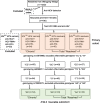Polymorphisms in the Th17 cell-related RORC gene are associated with spontaneous clearance of HCV in Chinese women
- PMID: 29866105
- PMCID: PMC5987631
- DOI: 10.1186/s12879-018-3153-2
Polymorphisms in the Th17 cell-related RORC gene are associated with spontaneous clearance of HCV in Chinese women
Abstract
Background: Female gender and favorable IFNL3 genotypes are the primary independent predictors of spontaneous clearance of HCV infection. However, chronic hepatitis C infection occurs in numerous women carrying favorable IFNL3 genotypes, indicating that other host and/or virological factors contribute to the prognosis of infection.
Methods: A cohort of 137 anti-HCV-positive female Han Chinese cases, including 64 chronic HCV carriers and 73 HCV spontaneous resolvers, was recruited in the study. 111 SNPs in 23 genes encoding HCV co-receptors, transcription factors, Toll-like receptors, co-stimulating molecules, and cytokines were selected for SNP analysis.
Results: After comparison of genotypes and allelotype frequencies of 111 SNPs in 23 genes in the primary cohort, the SNPs rs9826 (P = 0.024 for CC/TT/CT; P = 0.015 for C allele/T allele) and rs1521177 (P = 0.017 for GG/TT/GT; P = 0.006 for G allele/T allele) in the RORC gene were significantly associated with spontaneous HCV clearance. In the sub-cohort carrying favorable IFNL3 genotypes (rs12979860CC, rs8099917 TT, rs12980275 AA), rs1521177 (genotype: P = 0.040; allelotype: P = 0.021) remained significantly associated with spontaneous HCV clearance. Importantly, the most common RORC haplotype rs9826-T/rs1521177-T was presented at significantly different frequencies in resolvers and carriers in both the primary cohort (P = 0.0027) and the IFNL3 favorable sub-cohort (P = 0.0117).
Conclusions: This study indicates that genetic polymorphisms in human Th17-related RORC gene are associated with different natural prognosis of HCV infection. The RORC haplotype, rs9826-T/rs1521177-T, was favorable for spontaneous clearance of HCV infection.
Keywords: HCV; IFNL3; Polymorphism; RORC; Spontaneous clearance.
Conflict of interest statement
Ethics approval and consent to participate
The study was approved by the institutional review authorities of Peking University Health Science Center (Approval ID: PKUPHLL20090011). All patients provided written informed consent before enrollment in the study.
Competing interests
The authors declare that they have no competing interests.
Publisher’s Note
Springer Nature remains neutral with regard to jurisdictional claims in published maps and institutional affiliations.
Figures

Similar articles
-
Distribution of IL28B rs12979860 and rs8099917 Genotypes in Patients with Chronic Hepatitis C Virus Infection in Tianjin, China.Clin Lab. 2018 Apr 1;64(4):543-550. doi: 10.7754/Clin.Lab.2017.171036. Clin Lab. 2018. PMID: 29739095
-
Polymorphisms in the IFNL3/IL28B gene and hepatitis C: from adults to children.World J Gastroenterol. 2014 Jul 28;20(28):9245-52. doi: 10.3748/wjg.v20.i28.9245. World J Gastroenterol. 2014. PMID: 25071317 Free PMC article.
-
Polymorphism rs368234815 of interferon lambda 4 gene and spontaneous clearance of hepatitis C virus in haemodialysis patients: a case-control study.BMC Infect Dis. 2021 Jan 22;21(1):102. doi: 10.1186/s12879-021-05777-6. BMC Infect Dis. 2021. PMID: 33482747 Free PMC article.
-
Predictive power of Interleukin-28B gene variants for outcome of Hepatitis C Virus genotype 4 in Egyptians: A systematic review and meta-analysis.Clin Res Hepatol Gastroenterol. 2021 Mar;45(2):101480. doi: 10.1016/j.clinre.2020.06.006. Epub 2020 Jul 1. Clin Res Hepatol Gastroenterol. 2021. PMID: 32622719
-
Association of Interleukin 28B Polymorphism with Clearance of Hepatitis C Virus: A Mini Review.Crit Rev Eukaryot Gene Expr. 2020;30(3):223-229. doi: 10.1615/CritRevEukaryotGeneExpr.2020029692. Crit Rev Eukaryot Gene Expr. 2020. PMID: 32749108 Review.
Cited by
-
Like a Rolling Stone? A Review on Spontaneous Clearance of Hepatitis C Virus Infection.Viruses. 2024 Aug 30;16(9):1386. doi: 10.3390/v16091386. Viruses. 2024. PMID: 39339862 Free PMC article. Review.
-
Genetic variation in FOXP3 and ROR-γ genes in pediatric acute lymphocytic leukemia (ALL) patients: correlation with associated cytokines.Discov Oncol. 2022 Sep 9;13(1):86. doi: 10.1007/s12672-022-00549-3. Discov Oncol. 2022. PMID: 36083385 Free PMC article.
-
Chronic Hepatitis C Virus Infection Modulates the Transcriptional Profiles of CD4+ T Cells.Can J Infect Dis Med Microbiol. 2021 Mar 12;2021:6689834. doi: 10.1155/2021/6689834. eCollection 2021. Can J Infect Dis Med Microbiol. 2021. PMID: 33777278 Free PMC article.
References
MeSH terms
Substances
Grants and funding
- 2017ZX10202101-003, 2017ZX10301101-001 and 2017ZX09309008-003/National Science and Technology Major Project of China/International
- 2015SKLID506/State Key Laboratory of Infectious Disease Prevention and Control/International
- 81271826/National Natural Science Foundation of China/International
- 81201286/National Natural Science Foundation of China/International
LinkOut - more resources
Full Text Sources
Other Literature Sources
Miscellaneous

